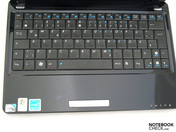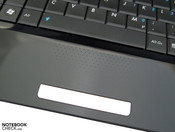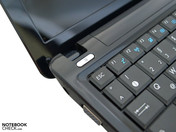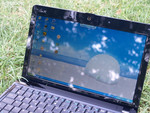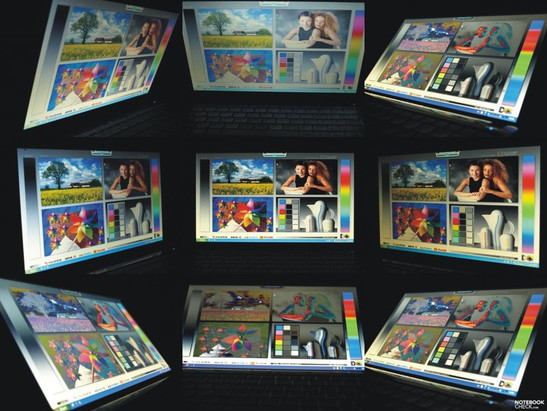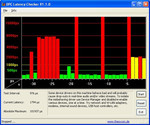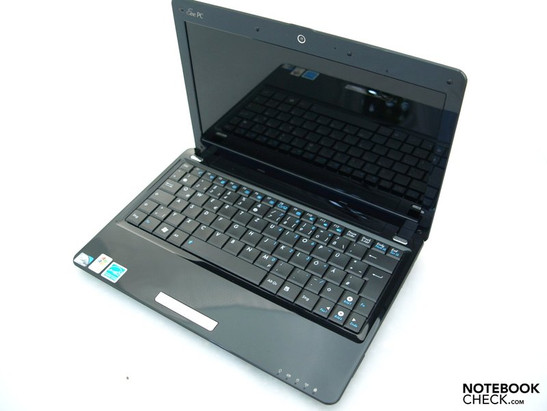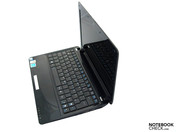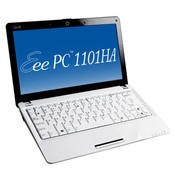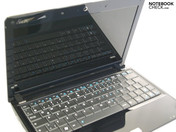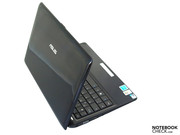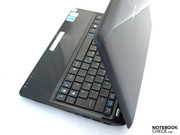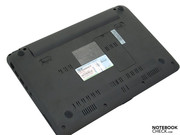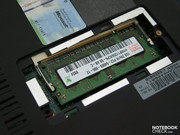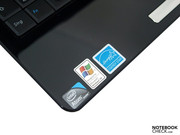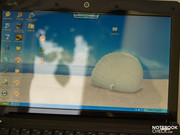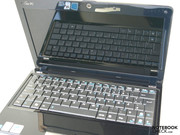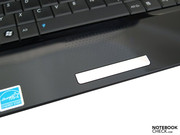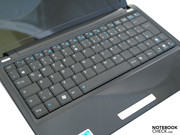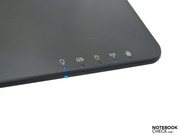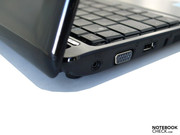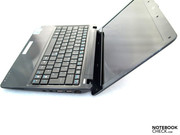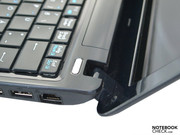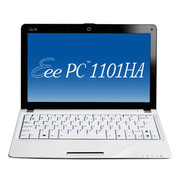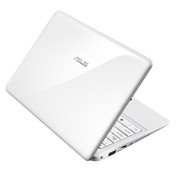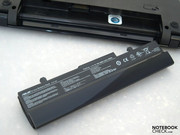Review Asus Eee PC 1101HA Netbook
The Eee PC netbook has grown!
'Netbook inventor' Asus presents its latest achievement in the Eee PC 1101HA. Although Asus is constantly expanding and adapting its range of small and mobile mini-notebooks, the difference here is clear from the first glance. For the first time, the netbook pioneer has produced a larger WXGA screen, at 11.6 inches. But despite the inevitable increase in size and weight, the Eee PC 1101HA is still focused on portability above all else. Read on to see how this €399 machine fares in our tests.
There are already a wide variety of Eee PC models. Starting with the original Eee PC, the Asus Eee PC 701 from 2007 with its 7 inch screen, the Eee PCs have grown to 9 inch and 10 inch versions, now reaching a new level with the 11.6 inch Asus Eee 1101HA.
Nevertheless Asus remains true to its focus on portability and above all promises up to 11 hours battery life (with a 63 Wh battery) and comprehensive networking capabilities. This is confirmed with a glance at the hardware: the integrated Intel Atom Z520 chip, with a thermal design power of only 2 Watts, is currently one of Intel's most energy-efficient processors.
Case
As with the Asus Eee PC 1008HA, the shape of the Asus Eee PC 1101HA is supposedly inspired by seashells. Be that as it may, the netbook is genuinely elegant, with its gleaming surfaces and its profile tapering at the front. It is available internationally in Crystal Black, Pearl White, Royal Blue and Rose Pink.
For all colour choices Asus is relying on so-called IMR (In-mold Roller) technology to make the glossy finish less prone to scratching. Only long-term use will show whether this actually works in practice. In any case, our black test model proved very susceptible to unsightly fingerprints and other dirt marks.
The gentle wedge-shaped curve of the netbook is pleasant, and leaves the base section at a slight incline; along with the matt keyboard surface, this make typing more ergonomical.
The angular, self-closing hinges, affixed to the lid, limit the opening angle to a maximum of about 132 degrees. Unfortunately they fail to prevent it from wobbling noticeably when it is adjusted. The lid also moves of its own accord in some situations when jolted. When the closed notebook is held upside down, the hinges do not prevent it from opening somewhat. Since there is no locking mechanism, when carrying the notebook around it is advisable to use the protective case that comes with it, to prevent any objects from getting into the space between the keyboard and the screen.
Connectivity
Very typically for a netbook, this model has three USB 2.0 ports, a VGA connection, a LAN (RJ-45) port and audio ports. The integrated card reader supports MMC and SD (SDHC) formats. As usual, the netbook user will have to do without any additional ports which might be of use; for instance docking ports, which are mostly reserved for more expensive subnotebooks and business devices.
The way the ports have been arranged is also fine. While there was no room to put any ports on the front or back edges, the distribution of ports is otherwise practical for right- and left-handed people alike.
As you would expect of a netbook, the Asus Eee PC 1101HA offers barely any maintenance or upgrade possibilities. However, there is a single access panel on the underside, which allows a RAM upgrade, even by owners without much technical knowledge.
In terms of networking the Eee PC 1101HA scores well by having an Atheros W-LAN module, the Atheros AR9285 Wireless Network Adapter, which supports Draft-N. Models with an integrated broadband modem are not (as yet) offered. As far as wired communication is concerned, the Atheros AR8132 PCI-E Fast Ethernet Controller (10/100Mbit) is provided for ordinary Ethernet connections via RJ-45.
The already perfectly respectable 160 GB hard drive is expanded through 10 GB of online storage (Eee Storage). The operating system is Windows XP Home, as is usual for a netbook, but GNU/Linux is also offered as an alternative.
Input devices
Keyboard
In contrast to the high gloss finish of the surrounding parts, the individual keys have a pleasant matt finish and smooth feel. Typing comfort is further enhanced by the slight incline caused by the wedge-shaped body and the good mechanical properties of the keys, which depress to a good depth and respond firmly. The size of the keys is generally satisfactory given the overall size constraints. The only negative here is the small right shift key; hitting it will require some practice. Other than that there are no surprises in terms of keyboard layout. Because of lack of space there are hardly any separate hotkeys, but all important functions can be completed with use of the function (Fn) key. The single exception is a button above the keyboard for disabling or enabling the touchpad.
Touchpad
As with the Eee PC 1008HA, the Eee PC 1101HA’s palm rest area and touchpad form a single entity without edges or recesses. The touch-sensitive area is distinguished by its dimpled surface. While this feels a little odd at first, most users will get used to it after a short while without any problems. More problematically, with the default driver settings, the touchpad is sensitive to the ‘tap to click’ and 'Multi-Touch' features, so that they are sometimes activated accidentally.
The touchpad buttons are made to look like a single chrome button. However they only really respond well at the edges, whereas the central area requires more pressure and can be unresponsive to the user’s input. One positive is that the clicking noise is quiet.
In addition the touchpad can be easily disabled when required. The hotkey for this is positioned above the keyboard to the left. Mirroring the on/off button, it is reminiscent of the ‘PowerSmart’ button that you often find on Acer notebooks.
Display
The integrated display from AU Optronics Corp. (AUO), model B116XW02V0, provides a 1366 x 768 pixel resolution in a widescreen 16:9 format. As well as the glossy screen surface, which is often considered inappropriate, especially for mobile notebooks, the netbook also fails to impress with its brightness. The maximum brightness value, measured in the bottom left segment of the screen, is only 135 cd/m². It is fairly even however, with a uniformity of 83%. Overall the netbook is not suitable for extended use in the workplace or outdoors. Once again this clearly shows the orientation of these netbooks towards their target market.
| |||||||||||||||||||||||||
Brightness Distribution: 83 %
Center on Battery: 118.6 cd/m²
Contrast: 198:1 (Black: 0.6 cd/m²)
All the same, with a low black value of 0.6 cd/m² and the measured maximum brightness in the middle screen segment, the netbook achieves a good contrast ratio of 198:1. Also subjectively the colours look clear and vibrant.
While the horizontal viewing angle is generous, the viewing angles along the vertical axis are unconvincing. Even small deviations from the ideal 90 degree viewing angle lead to distortions, appearing in the form of a darkening of the picture when viewed from below as well as an over-brightening of the picture when seen from above. At even greater angles you can also see some inversion of colours. Although the usable viewing angles along the horizontal axis are somewhat wider, you have to deal with more disruptive reflections because of the flat angle.
We tried boosting the low screen brightness with the Eeectl tool. However, with the Asus Eee PC 1101HA this does not lead to any improvement and the screen remained dark.
Aside from the fact that the program was unsuccessful in this case, it should also be mentioned that Asus advises against the use of this tool, warning of possible damage to the display and display controller. You should therefore only use the program if you are aware of the risks and understand that it may invalidate your guarantee.
Performance
Saving energy and thus increasing portability were the main criteria behind the design of the Asus Eee PC 1101HA. With the Intel Atom Z520 processor and the Intel US15W chipset (codename Poulsbo), with integrated GMA 500 graphics, it does live up to this goal, but at the cost of processing power. With a thermal design power (TDP) of only 2 Watts, the Atom Z520 even undercuts the thermal power loss of the Atom N270 or N280 processors, commonly used in netbooks at present, which have a 2.5 Watt TDP.
No great processing feats should be expected, simply because of this combination of the Atom Z520 CPU and the GMA graphics chipset. 1GB of RAM completes the package. As you would expect, the Asus Eee PC 1101HA is similar in terms of performance to the Sony Vaio VGN P21Z and the Acer Aspire One 751, already tested by us, which are comparably equipped. For instance the 1101HA scored 888 points in the PCMark05 test, whereas the Vaio VGN P21Z and the Acer Aspire One 751 scored 916 (+3%) and 692 (-22%) respectively. From the 3DMark tests consider for example the 3DMark03 value – here the 1101HA’s 418 points are roughly level with the Sony VGN P21Z which scored 425 points (+2%) and the Aspire One 751 which scored 413 points (-1%). In the 3DMark05 test we see a similar picture, with 146 points for the 1101HA, 126 points (-14%) for the Sony Vaio VGN P21Z and 136 points (-7%) for the Aspire One 751.
Netbooks with the more common combination of Intel Atom N270 or even N280 processor and GMA 950 provide a markedly better performance according to benchmarks. As a comparison, the Asus Eee PC 1005HA (N270, GMA 950, 1GB RAM) scored 1617 points in the PCMark05 test, a performance 82% better than the 1101HA.
Nonetheless, office tasks, internet browsing, Skype and so on are well within the 1101HA’s grasp and it handles them without difficulty.
As you would expect, the only mass storage device is the hard drive, a Hitachi HTS543216L9SA00 which provides 160GB total capacity. With a rotation speed of 5400 rpm it is unremarkable.
| PCMark 05 Standard | 1088 points | |
Help | ||
| 3DMark 2001SE Standard | 888 points | |
| 3DMark 03 Standard | 413 points | |
| 3DMark 05 Standard | 146 points | |
| 3DMark 06 Standard Score | 68 points | |
Help | ||
We also tested the latencies under Windows XP using the DPC Latency Checker program. With high latencies observed at times, there could be synchronization problems when external devices are connected, such as crackles of sound when using external sound cards. The image to the right illustrates the problems.
Emissions
System noise
The Eee PC 1101HA is very quiet, producing a maximum of 31.2dB(A) when idle or with light use. With a heavier system load it gets somewhat louder, reaching a maximum value of 37.2 dB(A). All in all it is a relatively quiet machine which produces a pleasant low-frequency sound.
Noise level
| Idle |
| 31.2 / 31.2 / 31.2 dB(A) |
| HDD |
| 31.4 dB(A) |
| Load |
| 31.4 / 37.2 dB(A) |
 | ||
30 dB silent 40 dB(A) audible 50 dB(A) loud |
||
min: | ||
Temperature
The heat build-up is very unobtrusive, both in the keyboard area and on the underside of the machine. Even with heavy use the upper side reaches a maximum temperature of 34.3 degrees Celsius, while the underside even manages to stay somewhat cooler with a maximum 31.1 degrees Celsius. Working with the notebook on your lap is therefore not a problem.
(+) The maximum temperature on the upper side is 34.3 °C / 94 F, compared to the average of 33.1 °C / 92 F, ranging from 21.6 to 53.2 °C for the class Netbook.
(+) The bottom heats up to a maximum of 31.1 °C / 88 F, compared to the average of 36.6 °C / 98 F
(+) In idle usage, the average temperature for the upper side is 30 °C / 86 F, compared to the device average of 29.8 °C / 86 F.
(+) The palmrests and touchpad are cooler than skin temperature with a maximum of 31.8 °C / 89.2 F and are therefore cool to the touch.
(-) The average temperature of the palmrest area of similar devices was 29.3 °C / 84.7 F (-2.5 °C / -4.5 F).
Loudspeakers
The loudspeakers, placed along the front edge of the machine, project their sound downwards. Asus clearly put some thought into sound quality, as the SRS Premium Sound True-to-life 5.1 Surround Audio provides a good, relatively balanced, range. The sound quality via the 3.5mm head phone jack is also without problems.
Battery life
Asus promises up to 11 hours battery life on its website. However this is only true for machines with the 63 Wh, 6-cell lithium-ion battery. For those with the 48 Wh lithium-ion battery, like our test model, 9.5 hours of offline use should be possible.
In the Battery Eater Reader’s Test (with minimum brightness and wi-fi disabled) the Asus 1101HA lasted for 584 minutes, which is 9 hours and 44 minutes of battery usage, exceeding the manufacturer’s claims. With wireless surfing and the maximum screen brightness the power drain increased, but the battery still lasted 367 minutes, around 6 hours.
Under a full system load, wireless modules turned on and maximum screen brightness, we reached 326 minutes, about 5.5 hours, on the Battery Eater Classic test (minimum achievable run time).
| Off / Standby | |
| Idle | |
| Load |
|
Key:
min: | |
Verdict
Asus has delivered a complete package with pleasing portability in the Eee PC 1101HA. Despite its excellent battery life it does not belong to the absolute front-runners of the field in this respect, but to be able to work for at least 6 hours away from a mains power supply is still pretty useful. You should not expect great performance from it, but the combination of the Intel Atom Z520 CPU, the integrated GMA 500 graphics chip and 1GB of RAM on Windows XP is sufficient for simple office tasks and surfing the web.
Regretably the major stumbling block to mobile use turns out, once again, to be the screen. With a highly reflective surface and low brightness levels, it is not recommended for outdoor use – which is a shame. On the positive side, it has a larger usable work area than previous Eee PC models, thanks to the 1366 x 768 pixel, 11.6” screen, though this of course increases its size and weight.
As is to be expected with netbooks, the Asus Eee PC 1101HA is clearly targeted towards a specific market. At a reasonable price it offers sufficient mobile performance and is also attractively designed, if a little hard to keep clean.









